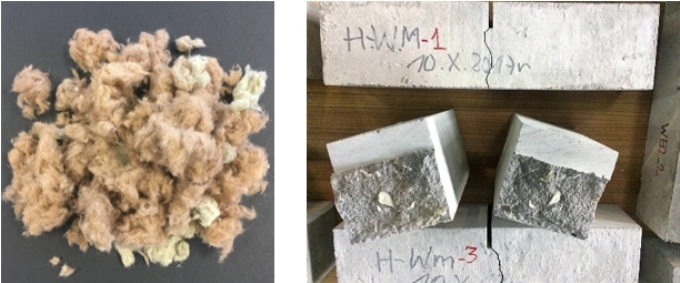Jul 18 2019
Research conducted by scientists from the School of Building at Universidad Politécnica de Madrid (UPM) has demonstrated how mineral wool waste can be an ideal alternative to the reinforced fibers that are now being used in building materials.
 Wool fibers waste and fracture energy test of mortars reinforced with mineral wool fibers waste. (Image credit: Carolina Piña Ramírez)
Wool fibers waste and fracture energy test of mortars reinforced with mineral wool fibers waste. (Image credit: Carolina Piña Ramírez)
In addition, they enhanced the thermal and mechanical properties of the added products, preventing their storage in landfills. The outcome is a new cement mortar that reuses insulating materials and minimizes the use of sand, which helps execute the criteria of circular economy in the construction industry.
Building construction poses a critical environmental issue; therefore, the resulting construction and demolition waste (CDW) can be employed to replace part of the raw building materials. Specifically, mineral wool waste from the insulation of homes has increased recently because of the increase in acoustic and thermal demands.
Almost 0.2% of the volume of all CDW produced are mineral wool, constituting 60% of the insulating materials used in construction. Furthermore, it is expected that in 2020, over 2.5 million mineral wool waste will be produced in the EU-28 zone, characterized by its low recycling rate, complicated reuse, and forms of recovery.
For many years, a group of UPM scientists has been investigating ways to recycle construction materials to construct houses. In this manner, they determined that the chemical structure and the microstructure of mortars that add recycled fibers are comparable to the mortars without such fibers.
This means that no considerable variation is caused by adding the fibers that impact the functionality of the mortar; hence, this recycled material would be appropriate for construction.
Moreover, they confirmed that the properties of the recycled fibers are left unaffected, though they originate from a landfill. Furthermore, “it has been scientifically proved the mortars incorporating recycled mineral wool wastes are lighter so they could improve their insulating properties” Mercedes del Río, an expert involved in this project, states.
In an earlier study, it was concluded that the resultant compounds have mechanical properties comparable to other currently used commercial compounds, and they also possess a superior flexural strength because of the addition of this waste. Moreover, such resistance is analogous to those that include commercial polymeric fibers; however, the commercial fibers are not sustainable, as they require a huge amount of energy for their production.
In their most recent study, the UPM scientists, together with the Bialystok University of Technology, suggested minimizing the aggregate—sand—used for the production of cement mortars by waste to the maximum, as sand is the most demanded natural resource across the world, ahead of fossil fuels and followed by water.
According to Carolina Piña, the lead researcher of this study, “it is possible to replace up to 50% of the volume of the sand using these sustainable mortars, which means a large amount of raw material savings and high-volume recycling of mineral wool.”
The study outcomes indicate that the use of mineral wool fibers in cement mortars decreases the environmental effect as they minimize the use of aggregate and revalue this waste that ends up in a landfill at present.